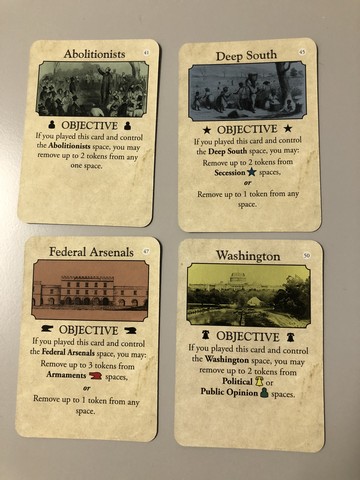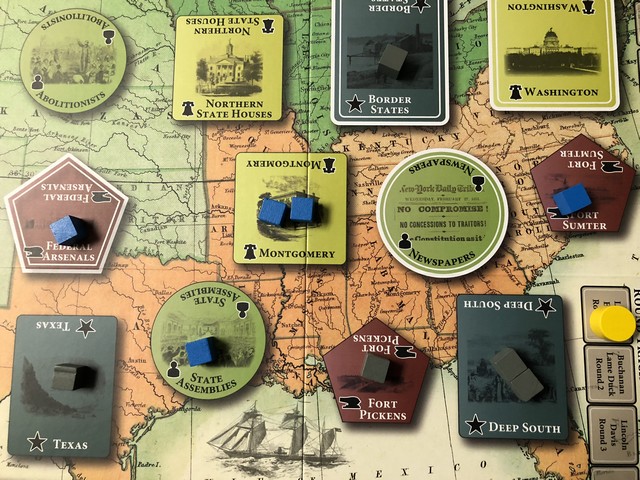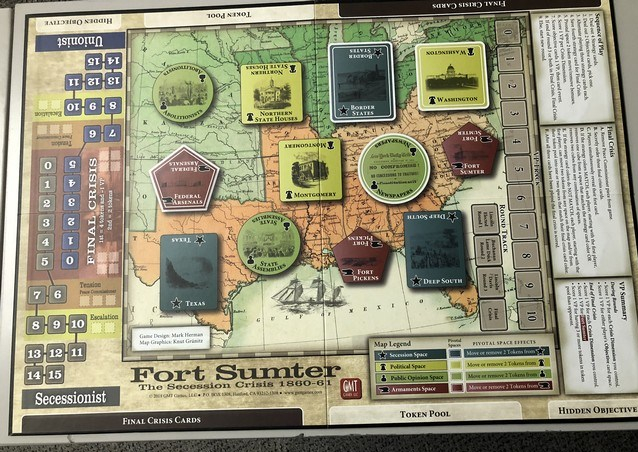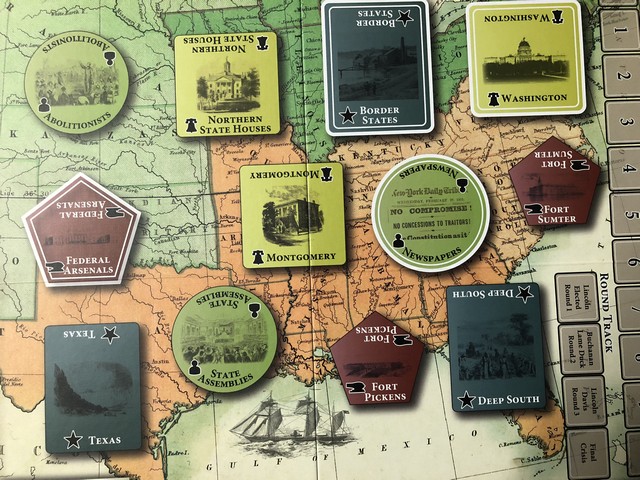Dude! Take Your Turn!
A Gaming Life
Review – Fort Sumter: The Secession Crisis, 1860-61
(Edit – 3/26/19) – Guess what! Playdek is bringing this game to digital platforms!
Check out my post with the announcement.
(Edit – 5/27/19) – Here’s my review of the app!
(Edit: This is one of my Top 25 Games Played of all Time, as of February 2019 anyway. Check out the other games as well!)
Original post below.
The Civil War (or “American Civil War” for those who aren’t, you know, American) was one of the bloodiest wars in American history, and many military history buffs know a lot about the battles that took place in it.
Gettysburg, Antietam, Vicksburg, all are extremely well-known to anybody with a bit of knowledge about the war.
What isn’t necessarily as prominent in the eye of those not steeped in history is what led up to the war. What led to brother fighting brother, families being torn apart, Clark Gable getting his best known role a country being divided unto itself?
Fort Sumter: The Secession Crisis, 1860-61 is a game that will give you a little bit of that history (and that is last time I’m writing the entire name out. From now on, it will just be Fort Sumter).

Fort Sumter is a 2-player card-driven game designed by Mark Herman, with art by Knut Grünitz and Rodger B. MacGowan and published in 2018 by GMT Games. It plays in 25-40 minutes (in my experience, it’s been around 25-30 though).
The two players take the two sides in the struggle to determine whether the United States would divide over the issues of states rights, slavery, and all of the other ways that the southern states felt like they were being dominated by the federal government. Ultimately, the winner of the game will be the side that most effectively galvanized its people for the coming war.
(The game comes with a wonderful Playbook that covers not only some good strategies for the game but also all of the history. It’s 3-4 times larger than the rulebook!)
One player is the blue Unionist side and the other is the grey Secessionist side.

Political influence tokens are set up on the Crisis Track (15 for each side, plus extras). Players do not start with any tokens in their token pool.
The map has four “Crisis Dimensions” of three areas each: Secession (Grey), Armaments (Red), Public Opinion (Green) and Political (greenish-yellow). Each Crisis Dimension has one area that’s called the “Pivotal Space”, which is the space that will give its controller some special abilities at the end of the turn. These spaces are outlined in white.
Each game will go three rounds, or fewer if both players have breached the “Final Crisis” area of the Crisis Track (more on that later).

At the beginning of the round, each player will be dealt two Objective cards and four Strategy Cards.
They’ll choose one of the Objective cards and that will be a goal for that round. The other one will get shuffled back into the deck (there are 12 in total, one for each space).

Then, starting with the player who’s ahead in victory points (Unionist if it’s a tie, like on the first turn), each player will alternately play one Strategy Card.
The number in the top left corner is the number of political influence tokens that you can place anywhere on the board.
However, if the colour matches the player’s colour (or if it’s both blue and grey, like all of the 3-point cards), you can play it for the event instead. The event is usually much cooler, but more limited in scope (such as applying to only one crisis dimension, or even just one space).
When you place influence tokens, you first must use what’s in your “Token Pool,” but if you don’t have any, then you will be removing them from the Crisis Track (remember, you don’t start with any in your pool).
The track is divided into three zones (four if you count the “the game hasn’t started yet” zone which has 5 tokens in it).
The three zones are “Escalation,” “Tension,” and “Final Crisis.”
When you “breach” each zone (meaning you took the first token in that zone), something happens. For Escalation, you will take the two extra tokens into your Token Pool.
For Tension, when the first player breaches it, they not only will get the extra tokens that are there, but also the other player will get to play the Peace Commissioner (a neat little white meeple) into one of the spaces on the map. Once placed, the Peace Commissioner prevents any influence from going into or out of the space. It’s effectively frozen. There are also three cards that allow movement of the Peace Commissioner as well.
The Final Crisis area is special, though. The first player to breach it will lose 1 VP, but will get all four extra tokens.
The second player to breach it will only get two of the four extra tokens.
Once each player has played three cards, the fourth card goes into the “Final Crisis” area on their side of the board, to be used in the (duh) Final Crisis stage of the game.

Then round scoring happens. First, the Pivotal Spaces for each Crisis Dimension are examined. In turn order, each player looks at the Pivotal Spaces they control (i.e. have more influence tokens than the opposing player) and then have the option of either moving two tokens around in that Crisis Dimension or removing two opposing tokens from the dimension (or you can do one of each)
After that happens, each player gets one VP for each full Crisis Dimension they control (meaning that they control all three spaces in the dimension).
Objective Cards are then revealed. If you control the space on the card, you get a VP and you get to do the action on the card (usually removing opposing tokens).
Did both players breach the Final Crisis zone of the Crisis Track? You now go to the Final Crisis. If they didn’t, then you move to the next round (unless it’s the third round in which case you do go to the Final Crisis). Deal two more Objective cards and four more Strategy cards and repeat.
The Final Crisis is the cool part of the game, though.
Each card has a Crisis Dimension colour/name on the bottom of the card.
You take the three cards that you set aside in earlier rounds, place them in any order you want, and then reveal them one at a time simultaneously with the other player.
If the two cards match, in turn order players must remove one of their tokens from that Crisis Dimension or two tokens from anywhere else.
If they don’t match, then again in player order players may move up to two tokens from any spaces or their token pool into one or two spaces of that dimension type.
After those three rounds, each dimension is scored one more time, the player who controls Fort Sumter gets one VP, and if either player has at least three tokens in their pool more than the other player they also get a point.
Most points wins!
Ties are broken by control of Fort Sumter, then whoever controls the most spaces if nobody did, and if it’s still a tie, the Unionist player wins.
Is Fort Sumter a Ken Burns miniseries or a Gods & Generals movie?
I love almost everything about this game. It’s interesting, fascinating history, and the cards have some great events that really put you in the middle of the crisis (I think there’s a card for when every state seceded, for example).
The game comes with 40 Strategy cards and you will only use 24, so there’s a lot of variability in the game play. The same with the Objective cards, as you will only use 6 of the 12 in any given game.
I have to comment first on the component quality.

The map is gorgeous. I mentioned that at first glance it looks cluttered, but when you really look at it, everything is in its place. The artwork on the map and on the cards is really great. The board is colourful and really catches your attention.

It would be nice if the Political spaces were a slightly different colour, though. The rules say that they’re yellow, but it’s more of a yellowish-green and while you can tell the difference between Political and Public Opinion, it could stand out more. The Secession (grey) and the Armament (red) areas are such a wonderful contrast that it would be nice if Political stood out just as much.
The Sequence of Play, Final Crisis, and VP summary are off to the side which make it so you never really have to look at the rules. The Map Legend helps with the Pivotal Space effects. Each player has a clearly-defined area for Final Crisis cards, their Token Pool, and where to place their Objective card.
All three of those player items are completely unnecessary but add a lot to the presentation of the game (the rules could have just said “keep your Objective card face down in front of you” for example).
The cards are of good quality, though I think I will have to sleeve them eventually.
Finally, GMT Games thinks so highly of their customers that they gave them one extra of every piece in the game (one extra blue cube, grey cube, turn marker, Peace Commissioner).
Either that, or it’s just a mistake in my game. (I like to think they knew they were sending out my copy and put a little extra love in it) (Editor: yeah, you keep thinking that)
The rule book is laid out well with some great examples. Even though there are only eight pages, make sure you read them closely. We completely missed that the Peace Commissioner is only placed once due to Tension zone breaching (we played a couple of games where it was placed after each time the zone was breached)
One niggling point that also requires that you read the rulebook closely (and this has been clarified on Boardgame Geek by Mark Herman) is that, for a few of the cards (and all of the Objective cards), the wording isn’t exactly clear on what you do.
For example, the Objective cards say that if you played this card “and control the (required space)”, you may do the event. What happens if the first player performs their event and suddenly the second player no longer controls that space? Does the second player get to perform their event?
The rules themselves state clearly that if you scored the VP, you get to do the event.
So the wording on a few cards is a bit suspect. Read the rules closely!
How is the game play?
It’s very tense and it seems to me (after 4 plays) that it’s well-balanced. It’s such a short game that it encourages instant replays.
My gaming friend at work and I played it over two lunch hours, two games each. The first set of games, both ended in ties where the Secessionist player held Fort Sumter so they won the game (we switched sides, so each player won one).
The next week, we played two more games (again switching sides) and the Unionist player won both games by at least 3 points.
I love the decisions required by the hand you’re dealt each turn. Just what area should you go for? It’s dictated a little by your Objective card but you do have to at least putter around in other areas or you’re basically giving the other player free victory points.
It’s a back and forth fight, especially for Fort Sumter, considering that not only do you get a point at the end of the game, but it’s the first tie-break as well. It’s only fitting in a game called…Fort Sumter.
I do like how even if it seems you are behind early, it is possible to come back with effective play. In both of our tied first games, one of us thought we were easily going to lose early in the game. It tightened up in later rounds.
Also in the “tough decisions” field are things such as “do I breach the Final Crisis zone first, giving up that luscious victory point when points may be few and far between?” You may have to because you need the cubes, and I like how the second player to breach only gets two of the four bonus cubes. Makes the decision that much harder.
The rules are simple but the strategies can be complex. However, sometimes they can be dictated by the cards you have, so keep that in mind if you’re one of those people who want to have total control over what your objectives are.
This is the perfect lunch time game if you have a gamer in your office. It plays short enough to get two plays in if you want. It’s quick to teach and easy to learn.
Maybe it’s too simple for the hardcore grognards? I don’t know. I wouldn’t think so, but keep that in mind if you are a grognard (If you’re reading this, can I call you “Mrs. Grognard?”)
But I know that it’s a game that will be in my collection a long time, and one that I know will get to the table a lot.
You should definitely give it a try.
(This review was written after 4 plays)
Great review! Do you happen to have played 13 Days which inspired Mark Herman to design Fort Sumter? If so, how do they compare?
LikeLiked by 1 person
Sadly I have not. I’ve played their Iron Curtain, which this far exceeds, though. Maybe one day I’ll get a play in!
LikeLiked by 1 person
Oh wow! I personally would rate Iron Curtain even above 13 Days. Gotta see if I can play a round of Fort Sumter asap!
LikeLiked by 1 person
After one play of Fort Sumter I can say that I like it (although I lost the Final Crises / the game). I also played and liked both 13 Days and Iron Curtain. Compared to the Crises track in Fort Sumter I prefer the DEFCON track in 13 Days. The DEFCON track gives me that feeling of uneasiness when increasing the severity due to pushing your influence in various regions. The Crises track (at the moment) does not give me that same feeling and just provides Political Capital Tokens (cubes).
Hopefully I will be able to play Fort Sumter a few more times soon and perhaps it changes my mind.
LikeLiked by 1 person
Pingback: New to Me – June 2018 – Dude! Take Your Turn!
Pingback: 5 on Friday: 13/07/18 – No Rerolls
Pingback: Top 25 Games Played of All Time (15-11) – Dude! Take Your Turn!
Pingback: Playdek Bringing Fort Sumter to Digital Soon – Dude! Take Your Turn!
Pingback: Review – Dual Powers: Revolution 1917 – Dude! Take Your Turn!
Pingback: News to Catch Up On – Dude! Take Your Turn!
Pingback: App Review – Fort Sumter – Dude! Take Your Turn!
Pingback: Red Flag Over Paris from GMT Games – Dude! Take Your Turn!
Pingback: Twilight Struggle: Red Sea – Conflict in the Horn of Africa – From GMT Games – Dude! Take Your Turn!
Pingback: October 2021 Monthly Update from GMT Games – Dude! Take Your Turn!
Pingback: December 2021 Monthly Update From GMT Games – Dude! Take Your Turn!
Pingback: New to Me – May 2022 – Dude! Take Your Turn!